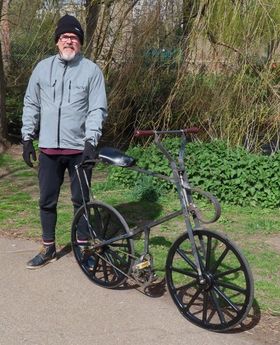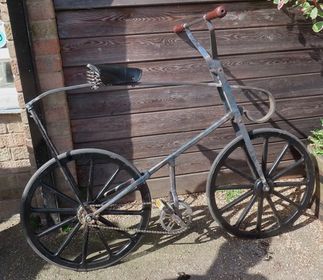- Home
- News
- Recreating the Sussex Dwarf by Edwin Knight
Recreating the Sussex Dwarf by Edwin Knight
12 July 2022
With help from our curators and designs held by the Science Museum, cycle enthusiast Edwin Knight has recreated lost Victorian bicycle, the Sussex Dwarf.
.jpeg)
Image: Coloured drawing of H.Lawson's first rear-chain-drive safety bicycle, 1873-4, made from information supplied by Mr. H Lawson.
1921-604 Science Museum Group Collection Online
Developed in 1873-4, the Sussex Dwarf was the first bicycle created by designer, racing cyclist and motor industry pioneer Henry John Lawson. Lawson is often ranked alongside John Kemp Starley as one of the inventors of the modern bicycle, and his Dwarf safety bicycle was the first to employ a chain drive to the rear wheel. He would later go on to co-found the Daimler Motor Company in 1896.
Edwin told us the story of how he came to build Lawson’s groundbreaking safety cycle, his experience of making and riding it, and his theories on why the model wasn’t more successful in its time. Read on to find out more...
Tendering
A couple of years ago I was asked if I would be interested in making an example of Lawson's first bike, by the author of the treatise on the subject, Mr. Nick Clayton. At the time I was very busy so my answer was negative.
Earlier this year, I met with Rob Damper at the Kent Oldest Bike Ride, who looked over my Rover No.1 and seemed to like what he saw. A short while later I received a paper from the Veteran Cycle Club (VCC) requesting me to tender for the build of the Sussex Dwarf, and to include a video of how it was built in 1873, using the Victorian methods of the time.
I was intrigued and felt that I could do it. I am lucky enough to count an excellent blacksmith, Peter Trick, among my very good friends. Peter is well-versed in the use of wrought iron, having been trained and employed for many years by the East London Bell Foundry, up until it closed for business. After its closure, he was given the full Blacksmith workshop and all the machinery and stock to help him continue with his chosen profession – so he was he ideal person for me to collaborate with on this project.
I perused the papers for a while and realised that there was so little to go on, that the design could easily result in a different bike from every person tendering. I also had grave reservations about the ability of the design not to fail or flex to a point of failure. Therefore, I thought the best way to get started would be to construct a proof of concept, i.e. to build a cheap construction using up-to-date methods and materials, in order to test my plans and save on expensive Victorian materials. I was intrigued enough to proceed with this at my own expense, with the aim of sharing my findings with anyone who wish to see the outcome.
Creating the Proof of Concept
I set about the construction, beginning with the only dimension the designs provided: the one thing I knew was that the wheels should be 23 inches in diameter. Using a combination of Lawson’s “fag-packet” sketches and interpretation from the Science Museum, which holds the designs, I had a go at scaling up some measurements.
My good friend John Gray drew up some wheel designs and provided the DXF files for the CNC router machine to make them out of plywood. These were later finished and coated in epoxy resin to give them a hard outer coating and help provide a strong wheel. Bronze bearing and solid tyres were fitted.
In the meantime, I contacted Peter who was prepared to draft up a tender for the job. As I am a hobbyist, I have little interest in competitive tendering, but luckily Peter has a great stock of high-grade wrought iron to hand. However, to create the cycle authentically, the iron would need to be reformed using a rolling mill – to do it by hand at his forge would be a very expensive and time-consuming process. He would wait until the proof of concept was available and we had agreed it was the best way forward before proceeding with the work.
The wheels returned from the CNC and I finished them off. The steel arrived and I set about machining it into the correct profile forms. It was at this point that I took a trip to the Coventry Transport Museum to take a look at the 1876 Lever cycle in its collection, which is the closest existing bicycle to Lawson’s Dwarf. The Lever cycle is fitted with a very similar front fork design, and has a lot of other features in common with the sketch I had to work from. Curator Megan Nass was a great help with learning more about this bicycle.
I subsequently set about constructing the frame, electric welding it together, and during this process I found the measurements and angles we’d decided on were a long way astray. The top spring would not fit and the wheels clashed with the pedals. I put this down to distortion in expanding the pictures. I set about amending angles, reshaping the spring and adding extra material in various places. Finally, the drive was fitted and away we went on a successful machine.


Images: Proof of concept for the replica Sussex Dwarf safety bicycle by Edwin Knight
Riding the Bicycle
Sadly, when I contacted Bob to tell him that the concept machine was ridable, he informed me that the VCC had cancelled the project. In the meantime, however, I was amazed at how well it rode! I think that if Lawson’s machine had actually been built, it would have been a world-beater, easily outshining any vehicle I have ridden from the same time period. This led me to wonder why it was ultimately abandoned.
My conclusion is that it may have been down to the type of chain available to the 21-year-old Lawson at the time. Having discussed the matter with fellow enthusiasts, we concluded that it was probably designed to use the Morgan-style chain. This kind of chain had very little lateral stability, so would have resulted in the bike swaying about when used in horizontal attitude as required by the Dwarf, and the derailment would have infuriated any rider.